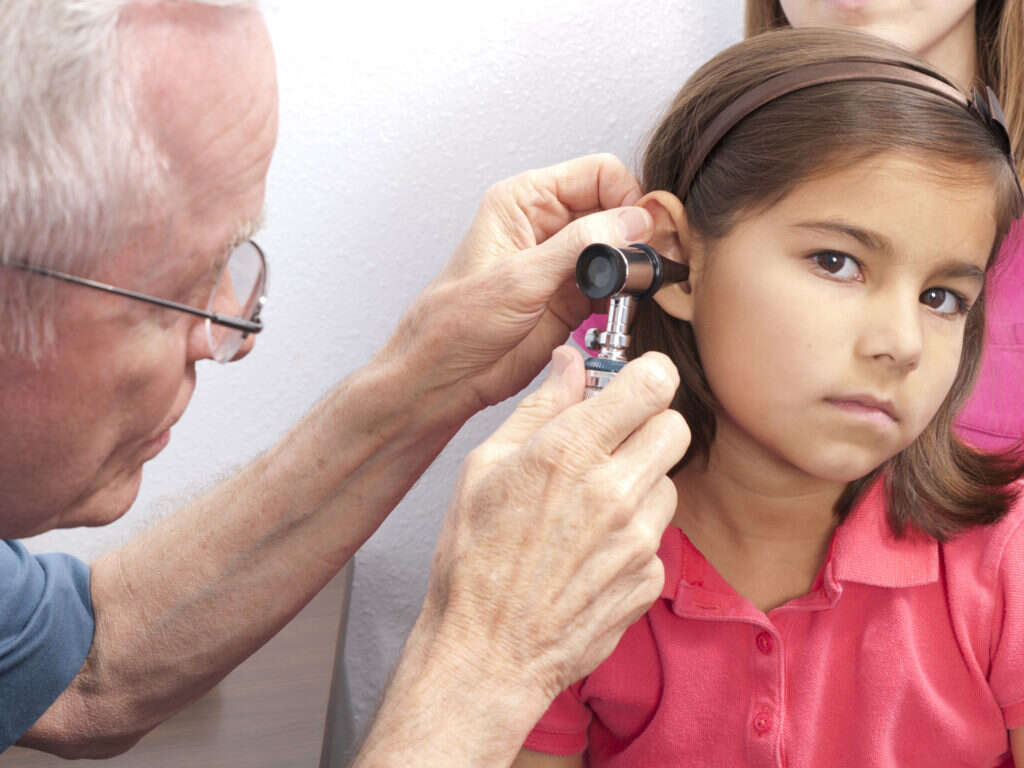Overview of a Middle Ear Infection
Symptoms, Causes, Diagnosis, and Treatment
OWERVIEW---------------------------------------------------------------------------------------------
There are a few kinds of ear infections, but otitis media is the most common. It occurs when fluid and pus build up in the middle ear, behind the tympanic membrane (eardrum), causing ear pain. This is often due to a cold or allergies that can block drainage, introduce bacteria or viruses, and cause inflammation.
Ear infections are much more common in young children but can occur in adults as well. Most can be easily treated with or without antibiotics, but ear tube placement may be recommended for chronic otitis media.
Otitis media with effusion (OME) is seen when there is fluid in the ear (often following a cold) but no active infection. An infection of the outer ear is called otitis externa (swimmer's ear).
Symptoms
For adults and older children, the most obvious symptom indicating otitis media is pain. Children often run a fever with ear infections, but not always. These symptoms usually appear after a cold or nasal congestion.
Babies and young children experience pain but they cannot tell their parents about their discomfort, so it's important to look for non-verbal clues that they may have an ear infection. These include:
- Pulling on the ear
- Crying more than usual
- Difficulty sleeping
- Drainage from the ear
- Problems with balance or hearing
- Decreased appetite
- Unexplained fever
You should check with your doctor as to when the child needs to be seen. Adults should call their doctor when experiencing ear pain or other symptoms and see whether they should wait or come in for an examination.
Symptoms of chronic otitis media may include hearing loss, chronic ear drainage, balance issues, facial weakness, deep ear pain, headache, fever, confusion, fatigue, and drainage or swelling behind the ear.
A frequent complication of otitis media is a ruptured eardrum due to the pressure of the accumulated fluid and pus, and you may experience vertigo. Rare complications include the infection spreading to the mastoid bone (mastoiditis) or other areas. Chronic otitis media in children can lead to hearing loss and impair speech and language development.
Causes
Though different kinds of ear infections can cause some similar symptoms, their causes differ.
A blockage of the eustachian tube that links the back of your throat with your middle ear sets the scene for otitis media. The tube can't drain the middle ear if you have increased inflammation, mucus, or congestion as often happens with an upper respiratory infection or allergic rhinitis. Bacteria or viruses can then multiply in the middle ear and cause an ear infection.
Babies who have not been breastfed for at least the first six months of life, who bottle feed while laying down, or use a pacifier beyond age 6 months are also at increased risk for an ear infection.
Smoking and exposure to second-hand smoke increase the risk. Other risk factors include cleft palate and other craniofacial disorders, enlarged adenoids, nasal polyps, and mucosal diseases such as sinusitis.
Chronic otitis media (COM) indicates that fluid is present in the middle ear for six or more weeks. It's a condition that generally occurs over many years among people who have frequent ear trouble.
OME can also happen if you come down with a cold or a sore throat and fluid accumulate in the middle ear due to swelling, but there is no active infection. The fluid usually goes away on its own within four to six weeks. It tends to occur more often in kids between the ages of 6 months and 3 years old. More boys are affected than girls.
Swimmer's ear (otitis externa) is different from otitis media in that bacteria multiply in water that is trapped in the outer ear canal. Swimming, naturally, is a common risk factor, but inserting fingers or cotton swabs into the ear can also contribute to this.
Diagnosis
Accurate diagnosis of an ear infection requires a visit to your healthcare provider. He or she will use a special instrument (otoscope) to look inside the ear to determine what type of ear infection may be present. Imaging usually isn't needed. However, if you have recurrent middle ear infections, a CT scan or MRI may be done to look for structural abnormalities or abscesses.
Treatment
Many middle ear infections clear up by themselves after a couple of days. Your doctor can advise you as to whether watching and waiting or a treatment is recommended.
Over-the-counter ibuprofen or acetaminophen can be used for ear pain. Once a doctor makes the diagnosis of an ear infection, antibiotics will be prescribed according to guidelines based on age and other criteria. Ear drops with a topical anesthetic may also be prescribed to help with ear pain.
If your child has chronic otitis media, your doctor may recommend having small tubes placed in his or her ears to help drain the fluid that is building up. Although this is a very common and fairly simple procedure, there are risks involved with any type of surgery or anesthesia and the decision should be one that is carefully evaluated by both the parents and physician.
Caregiving and Coping
Coping with an ear infection can be frustrating, whether it is your own or your child's. If antibiotics are prescribed, it is important to remember that you will typically not see any difference in symptoms for at least 24 to 48 hours. This means there could still be a fever and significant ear pain during that time. A child may continue to be fussy and have difficulty sleeping. Use pain relievers if needed and as directed; you may also try applying a warm or cool cloth to the affected ear.
Distractions such as videos, books, and games can take a child's focus away from the pain and discomfort. If you have spent too long with a fussy child, enlist help so you can take a break.
A Word From Verywell
Ear infections are a common part of childhood. Talk with your healthcare provider about what you should do if you see the symptoms in your child. For both you and your child, reduce exposure to secondhand smoke or stop smoking. Be sure to take steps to prevent colds and influenza, including getting recommended vaccinations and the annual flu shot.
SYMNPTONS------------------------------------------------------------------------------------------
When you have ear pain or suspect that your child does, you may be dealing with an ear infection. Infections of the middle ear are called otitis media and they are the most common type of ear infection individuals face. Discomfort, ear drainage, and muffled hearing are all common signs and symptoms, but less-specific ones (irritability, decreased appetite, and others) can also occur. These infections are usually easy to recognize in children who are able to articulate how they are feeling but can be more difficult for parents to identify in infants and toddlers.
:max_bytes(150000):strip_icc():format(webp)/ear-infection-symptoms1-5b588c3746e0fb00250b9ef0.png)
Frequent Symptoms
The common signs and symptoms of a middle ear infection in adults and children include:
- Ear pain (otalgia), especially just in one ear or when lying down
- Hearing loss: Sounds can be muffled as if you are wearing an earplug in the affected ear.
- A feeling of fullness in the ear
- Feeling like you are ill in general
- Ear drainage (otorrhea)
- Fluid behind the eardrum detected with an electronic ear monitor
Children often have a middle ear infection with a cold or soon after a cold; you can expect that they will have cold symptoms such as a cough and runny nose just before the ear infection sets in. Babies and toddlers obviously can't tell you they are feeling ear pain, so you will need to know the symptoms they commonly show.
In addition to those listed above, look for:
- Tugging on or holding the ears (this indicates pain, though it may not always be due to an ear infection)
- Showing signs of muffled hearing or hearing loss by not responding to sounds
- Fever of 100 degrees or higher
- Nausea, vomiting, and diarrhea
- Fussiness, irritability, excessive crying, inability to be soothed
- Trouble sleeping, either getting to sleep or staying asleep
- Decreased appetite
- Lethargy; lack of energy or interest in play
Rare Symptoms
The buildup of pressure in the inner ear can cause a ruptured eardrum, with a sudden flow of yellow, green, or bloody drainage from the ear. The ear pain can then subside quickly. You may have ringing in the ear and the spinning sensation of vertigo.
Otitis Media With Effusion
Otitis media with effusion, also called secretory otitis media, is an accumulation of fluid in the inner ear. It can follow a middle ear infection. In other cases, the effusion may have developed due to a blocked eustachian tube without infection, but the fluid traps bacteria that can develop into an ear infection.
Otitis media with effusion often has no symptoms, but it can be accompanied by:
- A feeling of fullness in the ear
- Mild hearing loss (you may turn up the volume on the television or a video)
- Cracking or popping sounds with swallowing
Chronic Otitis Media
Chronic otitis media (repeat infections or ongoing infections) can lead to additional signs and symptoms, as well as indications that complications can be developing. You or your child may have renewed symptoms of an ear infection after having a cold or getting water into the middle ear (due to a perforated eardrum). These may include:
- Hearing loss
- Chronic ear drainage
- Drainage and swelling behind the ear
- Balance issues
- Facial weakness
- Deep ear pain
- Headache
- Confusion
- Fatigue
Complications
The eardrum can rupture due to the pressure of the accumulated fluid and pus in the ear. A hole or a small tear develops in the eardrum (tympanic membrane). Usually, this will heal on its own in a few weeks without the need for medical treatment. The spinning sensation you can have with a ruptured eardrum can produce nausea or vomiting. You should see a doctor to get appropriate treatment. If the eardrum fails to heal, it may need surgical repair.
Middle ear infections can cause conductive hearing loss, preventing the transmission of sound from the outer ear to the inner ear. In children, repeated ear infections with conductive hearing loss can impair speech and language development and may cause kids to not be able to locate where sounds are coming from. Children may have more difficulty distinguishing and understanding words when they are in noisy places such as the classroom.
Such infections can contribute to auditory processing disorders. Permanent hearing loss is rare, but it can develop with prolonged and repeated infections.
Chronic otitis media can lead to labyrinthitis and damage to the delicate structures in the ear that help with hearing and maintaining balance. Cysts (cholesteatoma) can also develop in the middle ear.
Although rare, bacterial otitis media sometimes spread to the mastoid bone (mastoiditis) or to the inner ear. In extremely rare cases, the infection could spread to the brain and cause meningitis or an abscess.
When to See a Doctor
The American Academy of Pediatrics promotes an approach of treating the pain and waiting for two to three days to see if it goes away, as it usually will. You should check with your doctor as to when a child needs to be seen. Ear pain that worsens or doesn't improve, fever, and drainage with blood or pus—especially in a baby under age 6 months—require medical evaluation.
Adults should call their doctor when experiencing ear pain or other symptoms to learn whether they should wait or come in for an examination.
A doctor will be able to confirm the diagnosis by seeing signs of inflammation (redness, bulging) of the eardrum on physical examination.
If you or your child is treated for a middle ear infection, take note of when your doctor says you should have improvement. If the ear doesn't respond to treatment, or if new symptoms are noted, call your doctor or pediatrician. Similarly, if any new symptoms are noted after treatment for otitis media with effusion, mention them to your doctor.
CAUSES-----------------------------------------------------------
While children are at the greatest risk of middle ear infections (otitis media), adults can also experience them. Blockage of the eustachiantube is the usual cause, leading to bacterial or viral infection in the middle ear. This can be due to anatomic factors and triggered by colds, allergies, and other respiratory infections.
:max_bytes(150000):strip_icc():format(webp)/ear-infection-causes-5ae092fc8023b90036ca227d.png)
Common Causes
The most common cause of otitis media is eustachian tube blockage. The eustachian tube is a passageway from the back of your nose and throat to your middle ear, which is the part of your ear that is behind the eardrum. Your eustachian tube regulates air pressure in the middle ear and drains secretions from it. If the eustachian tube is blocked, fluid or bacteria become trapped inside the ear and cause an infection.
Eustachian tube dysfunction is more common in children because the passage is narrower and it doesn't have the slant it does in adults, so it doesn't drain as well. For some, the poor tubal function can persist into adulthood and is the main cause of middle ear infections in adults.
Adenoids, located in the back of the nose near the opening of the eustachian tubes, can block the tubes if they become swollen or inflamed. This is more of a problem in children because their adenoids are relatively larger.
Both bacteria and viruses can produce an ear infection once trapped in the middle ear. The most common bacteria involved are Streptococcus pneumoniae and Haemophilus influenzae, with less common infections owed to Streptococcus pyogenes and Staphylococcus aureus. Viruses include cold viruses (rhinoviruses), respiratory syncytial virus (RSV), influenza virus, and enteroviruses.
Standard childhood vaccinations protect against some of these agents and help prevent ear infections.
Common Risk Factors
The risk factors for blocked eustachian tubes and middle ear infections include:
- Age: Babies and toddlers between the ages of 6 months and 2 years are at the greatest risk for ear infections. This is because of the anatomy of the eustachian tube and the fact that their immune systems are still developing.
- Upper respiratory tract infections: Children are more at risk of catching colds because their immune systems have had less exposure to viruses (and, therefore, haven't developed defenses against them). That said, this is also a risk factor for adults.
- Allergic rhinitis: Seasonal hay fever, allergies to specific allergens, or chronic allergies can lead to ear infections in both children and adults. Allergies cause more secretions, and the inflammatory compounds released also irritate and damage the lining of the ears. Controlling allergies can help reduce the risk. However, antihistamines and decongestants have not been found to be of benefit in preventing otitis media in children.
- Malformation of the eustachian tube or craniofacial (head/face) disorders that cause palatal muscle weakness like cleft palate
- Mucosal disease of the ears, nose, or throat, such as sinusitis
- Enlarged structures in your ears, nose, or throat like the adenoids, turbinates, or nasal polyps
- A weakened immune system
- A family history of susceptibility to ear infections
Lifestyle Risk Factors
There are other risk factors you can modify, and these suggestions can help you do just that.
Avoiding getting colds and other upper respiratory infections are key to reducing the risk of middle ear infection. Wash your hands often and teach your children to cover coughs and sneezes to avoid spreading germs. For children with recurrent ear infections, you may want to consider reducing the time they spend in group child care settings, if possible.
Consider these additional steps to address risk factors for a middle ear infection that are within your control:
Babies and Children
- If you choose to breastfeed, consider doing so for at least six months so your baby benefits from the antibodies in your breast milk.
- Keep your baby in an upright position when bottle feeding. Don't prop up a bottle while your child is lying flat.
- Reduce the use of a pacifier once your baby is 6 months old, as some studies have found this increases the risk of ear infections.
- Avoid exposing babies and children to cigarette smoke; it impairs the function of the eustachian tubes and increases the risk of middle ear infections.
- Get the Prevnar 13 vaccine, which protects against ear infections by 13 subtypes of Streptococcus bacteria, and the annual flu shot.
- Leave any removal of earwax to a pediatrician. Cotton swabs and other objects can clog and irritate ear canals, leading to infection.
Adults
- Stop smoking and avoid secondhand cigarette smoke.
- Take a decongestant when you have a cold or before getting on an airplane so your eustachian tubes are less likely to be congested and you will be able to relieve the change in air pressure during ascent and descent.
- Avoid trying to clean your earwax using cotton swabs or other objects.
Like many infections, not receiving treatment for a middle ear infection can result in complications, including hearing loss in any age group and delays in speech and language development for children. There is also the risk of the infection spreading to the mastoid bone and other tissues. Seeking care from your doctor and following treatment recommendations can help avoid these complications.
DIAGNOSIS----------------------------------------------------------------------------------------------
Properly diagnosing an ear infection, also known as acute otitis media (AOM), shortens the duration of discomfort, is important to avoid overuse of antibiotics, and helps to prevent worsening infection. Aside from a thorough health history, your physician will likely only need to use a pneumatic otoscope to diagnose an ear infection.
Because young children can't always tell you what is wrong, finding out whether or not your child has an ear infection can be quite distressing as a parent. Fortunately, a trained physician can usually identify an ear infection without much difficulty. Also note that even if you didn't have an ear infection as a child, you can still get one as an adult.
:max_bytes(150000):strip_icc():format(webp)/ear-infection-diagnosis-5ae0a3f2875db90036a73309.png)
Self-Checks and At-Home Testing
You do not need to be a doctor in order to purchase the supplies needed to do an effective ear exam. However, it is not encouraged unless you know what you are doing, as there are subtleties to assessing the tympanic membrane (as described below).
Children also are notorious for not being cooperative during an ear exam. Without proper equipment and technique, there is a risk of accidentally perforating the eardrum if you insert anything too far into the ear.
However, there are companies that are making it easier for a quick check that you may find helpful before visiting your doctor. There are some smartphone attachments that will allow you to visualize the ear canal and tympanic membrane. There have also been some devices developed that will try to provide a scale of the level of fluid behind your tympanic eardrum; though the accuracy seems to be questionable based on online reviews.
Visual Examination
During the visit with your doctor, it will be important for them to examine your ear. Otoscopy is an exam performed with an otoscope that will allow for the visualization of your external ear canal and your eardrum (tympanic membrane).
While you can perform a basic assessment with a standard otoscope, it is best if your doctor has the pneumatic attachment for the otoscope. The pneumatic attachment is simply a rubber bulb that allows your doctor to apply light pressure to your tympanic membrane. Here is what your physician will be looking for in a normal eardrum:
- Position - the tympanic membrane will be in a flat or neutral position
- Translucency - the tympanic membrane is typically translucent
- Motion - the tympanic membrane will move with application of pneumatic pressure (both positive or negative pressure) from the bulb on the otoscope
- Color - the typanic membrane will appear pearly gray or pink
Findings that are suggestive of abnormalities in your inner ear include:
- Position - the tympanic membrane is either bulging or retracted
- Translucency - the tympanic membrane is opaque or cloudy
- Motion - the tympanic membrane doesn't respond appropriately to pneumatic pressure when using the bulb on the otoscope
- Color - gray, blue, amber, white, or pale yellow are all abnormal colors associated with the tympanic membrane.
Your physician will typically diagnose you with an ear infection if they see a bulging tympanic membrane
Imaging
You will not need any imaging for a standard work-up of an ear infection. However, if the infection is prolonged and your doctor is worried about other complications, they may order a CT scan or an MRI.
A CT scan can be useful in seeing the structures, abscesses, or other abnormalities around your ear. An MRI, on the other hand, is useful if your physician is concerned about any problems related to your brain. The use of CT or MRI would be rare and will not be part of a typical evaluation.
Differential Diagnoses
When assessing whether or not you have an ear infection, your doctor will try to differentiate if you have acute otitis media (ear infection) or otitis media with effusion (OME, non-infected fluid in the ear). Both can appear very similar.
Color, motion, and translucency may be variable between both AOM and OME. However, the position of the tympanic membrane is generally the tell-tale sign. In AOM, the tympanic membrane is typically bulging, while it is usually retracted with OME.
Redness
Redness of your tympanic membrane without signs of fluid behind the eardrum is not caused by an ear infection. Your physician may also look at these common causes of redness around the tympanic membrane:
- upper respiratory infection causing inflammation of the respiratory tract
- crying
- elevated fever
- ear trauma
- recent removal of ear wax
Decreased Motion
Testing for mobility of the tympanic membrane is important for the identification of middle-ear effusion (MEE - fluid in your middle ear). However, decreased mobility does not mean that the fluid in the middle ear is infected. Other causes of having decreased mobility of your tympanic membrane include:
- obstruction of the eustachian tube
- tympanosclerosis
Ear Pain
Having ear pain is a common symptom of an ear infection. However, there are many other reasons for experiencing ear pain including:
- otitis externa (swimmer's ear)
- ear trauma
- obstruction of ear canal with a foreign object
- temporomandibular joint syndrome
- herpes zoster (shingles)
Because of the many different diagnoses that can occur with symptoms of an ear infection, it is always important to follow up with a physician for proper diagnosis.
TREATMENT--------------------------------------------------------------------------------------------------
Proper treatment of an ear infection—also known as acute otitis media (AOM)— will greatly reduce the amount of ear pain that you are experiencing, as well as decrease your risk of other complications from an untreated infection. Options include over-the-counter therapies and prescription medications that your doctor can prescribe.
Explore these treatments for both pain and fighting the infection, as well as other treatments that you may want to understand.
Over-the-Counter Therapies
Pain is one of the most bothersome symptoms of an ear infection. Antibiotics will not help control ear pain (otalgia) for about 24 hours. Until antibiotics have had a chance to start working, you can use over-the-counter medications to help control the pain.
Ibuprofen or acetaminophen are the preferred options for children. Children under the age of 2 sometimes experience pain for three to seven days, so you will want to tailor the length of OTC pain control to how your child is reacting. You should ask your physician about over-the counter medications to ensure that you provide the right dose.
In general, here are standard doses for both ibuprofen and acetaminophen.
Ibuprofen
- Children: 4 to 10 mg per kg every 6 to 8 hours as needed
- Adults: 200 to 400 mg every 6 hours as needed
Acetaminophen
- Children under 6 years old: 10 to 15 mg per kg every 4 to 6 hours as needed
- Children 6 to 12 years old: 325 to 650 mg every 4 to 6 hours (not to exceed 1.625 grams per day)
- Children greater than 12 years old: 325 to 650 mg every 4 to 6 hours (not to exceed 3.25 grams per day)
Dosing for children is usually listed in kg (kilograms). To calculate this, take your child's weight in pounds and multiply it by 2.2. You will then need to multiply your child's weight in kilograms by the recommended dose per kilogram.
If you're using liquid medication, the side of the box lists how many milligrams are in each milliliter. You can draw the appropriate amount in either a syringe or pour into a medicine cup.
Prescriptions
A diagnosis of an ear infection will require antibiotics. Amoxicillin has been a successful first-line choice for over 25 years. It covers S. pneumonia but not two of the other less common community-acquired ear infections: nontypable H. influenzae and M. Catarrhalis.
However, amoxicillin is usually successful for treating an ear infection and another choice may not be needed unless you have an allergy to penicillin. If you have an allergy to penicillin, your physician may prescribe you cefdinir, cefpodoxime, cefuroxime, or ceftriaxone.
Amoxicillin Dosage
Usual dosing is based on the severity of the ear infection. For adults:
- Mild to moderate: 500 mg every 12 hours
- Severe: 875 mg every 12 hours
For children:
- 80-90 mg/kg per day in 2 divided doses
There are alternate dosing styles that your physician may want to use based on your symptoms or previous treatment history. A severe ear infection is usually classified as having severe hearing loss, high temperature, or severe ear pain.
Ear Drops
If over-the-counter pain medicine is not sufficient for pain control, your doctor may prescribe ear drops that contain a topical anesthetic. It is important to know that you should not use any ear drops with anesthetics if you have ear tubes in place.
Treatment Duration
Treatment will typically last for 5 to 7 days for the standard ear infection. However, your doctor may prescribe up to 10 days for a severe ear infection.
COPING AND Caregiving Tips-----------------------------------------
In most cases, this article will be for parents who are taking care of their child who is experiencing an ear infection. It can be difficult and frustrating to see your child in pain. It may help to know that even in the case of frequent recurring ear infections, most children grow out of this condition. This is true even in the majority of extreme cases that require the surgical placement of ventilation tubes.
Also rest assured that there are several things that you can do to help get through the 24 hour period before antibiotics have a chance to take effect, to reduce the pain your child feels.
Self-Care Tips
It can be hard for parents to leave their child when they aren't feeling well, but remember that unless you take care of yourself you will be unable to appropriately care for your child.
Take a Break
Consider allowing a trusted adult to watch your child on occasion. Caregiver burnout is a very real condition that can cause depression, physical and mental exhaustion, irritability, and can even make you more prone to becoming ill yourself. Despite your best efforts, experiencing these symptoms will have a negative effect on your sick child. Taking the time to workout or see a movie will prevent caregiver burnout and ultimately make you a better caregiver.
Don't Get Frustrated
If your child has been diagnosed with an ear infection, they have probably been fussy for several days due to the pain they are experiencing in their ears. You may feel frustrated as a parent that you did not know that they were having ear pain.
This is completely normal to feel frustrated with yourself, but know that you are not alone. The sometimes subtle pulling at the ear, or just plain fussiness, can be mistaken for any number of reasons. As soon as possible, start treating pain with over-the-counter medications.
Caregiving Tips
You can take steps to make your child as comfortable as possible.
Physical Accommodations
For the typical bout of an ear infection, you will not have any physical accommodation to make other than resting up. However, if your child suffers from recurrent ear infections, you may need to monitor their speech and hearing.
Either your primary care provider or an ear, nose, and throat specialist (ENT) can evaluate your child for chronic otitis media, or fluid in the ears, and determine if you need continued follow-up hearing exams or therapy with a speech-language pathologist.
Practical Tips
Treating your child with acetaminophen or ibuprofen will be a life-saver at the start of the ear infection. It will also be helpful for you to apply a warm or cool cloth to the affected ear. During this time, you should also:
- avoid getting water inside your ears
- avoid cleaning ear wax out
- avoid putting anything in your ears like a cotton swab
These relief tips will help you control your ear pain until antibiotics have taken effect. Distraction is a great technique so letting them watch their favorite movie or engage in another activity that can keep their mind off of their discomfort may be helpful.
Administer Medications Appropriately
In many cases, ear infections require the administration of antibiotics. These medications work best to decrease the length of time that your child is sick when they are given appropriately. This means that they are given as prescribed, on time, and for the entire length of time that your doctor has instructed. Watch your child for negative side effects or signs of an allergic reaction such as hives or a rash and notify your doctor if you are concerned.
It may also require some skill/instruction to give ear drops appropriately. Have your child lay on their side with the affected ear up and then gently pull the earlobe out and down. Keep your child in this position for several minutes to allow the ear drops to work.
See a Specialist
If your child doesn't seem to be getting better or seems to have an excessive number of ear infections it's a good idea to visit an ear, nose, throat doctor (an otolaryngologist).













